Questões de Vestibular de Inglês
Foram encontradas 5.955 questões

• A afirmação feita sobre a cadeira do anúncio
permite inferir que:

A New Zealand pizza chain aims to become the world's first company to offer a commercial drone delivery service, a milestone in the onceunthinkable quest to save time and money with an air-borne supply chain dispensing with people. Domino's Pizza Enterprises Ltd conducted a demonstration pizza delivery by drone in the New Zealand city of Auckland on Thursday, and afterwards said it aimed to be the first company to launch a regular drone service, late this year, despite the fact that Domino's Chief Executive Officer Don Meij had said in a statement "We've always said that it doesn't make sense to have a 2-tonne machine delivering a 2-kilogram order."
Even though Domino’s Pizza used in its test drones provided by U.S.-headquarted Australian drone company Flirtey, Philip Solaris, director of a New Zealand based drone company called X-craft Enterprises, said that while New Zealand has accommodating regulations on drones, Domino’s would be held back by a rule requiring drones to be kept in sight at all times, and added “I can't truly see how commercially viable that idea is because you would have to literally have somebody walking along to keep it in the line of sight, watching it at all times.” Other than that, he warned that “Domino’s service would still need to overcome random hazards (like) power lines, moving vehicles, children in the backyard playing”.
http://www.reuters.com/article/us-newzealand-drones-food-idUSKCN1100H0
Acessado 12/01/2017. Adaptado para fins educacionais

A New Zealand pizza chain aims to become the world's first company to offer a commercial drone delivery service, a milestone in the onceunthinkable quest to save time and money with an air-borne supply chain dispensing with people. Domino's Pizza Enterprises Ltd conducted a demonstration pizza delivery by drone in the New Zealand city of Auckland on Thursday, and afterwards said it aimed to be the first company to launch a regular drone service, late this year, despite the fact that Domino's Chief Executive Officer Don Meij had said in a statement "We've always said that it doesn't make sense to have a 2-tonne machine delivering a 2-kilogram order."
Even though Domino’s Pizza used in its test drones provided by U.S.-headquarted Australian drone company Flirtey, Philip Solaris, director of a New Zealand based drone company called X-craft Enterprises, said that while New Zealand has accommodating regulations on drones, Domino’s would be held back by a rule requiring drones to be kept in sight at all times, and added “I can't truly see how commercially viable that idea is because you would have to literally have somebody walking along to keep it in the line of sight, watching it at all times.” Other than that, he warned that “Domino’s service would still need to overcome random hazards (like) power lines, moving vehicles, children in the backyard playing”.
http://www.reuters.com/article/us-newzealand-drones-food-idUSKCN1100H0
Acessado 12/01/2017. Adaptado para fins educacionais
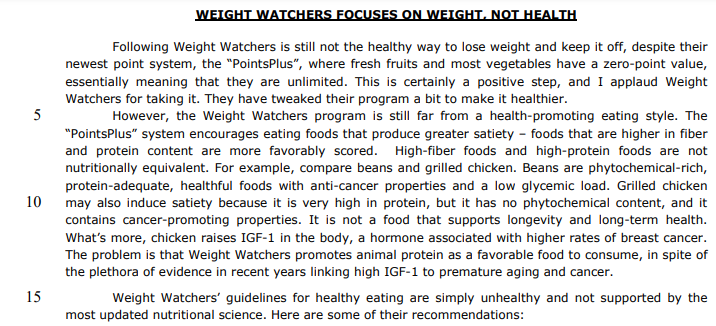
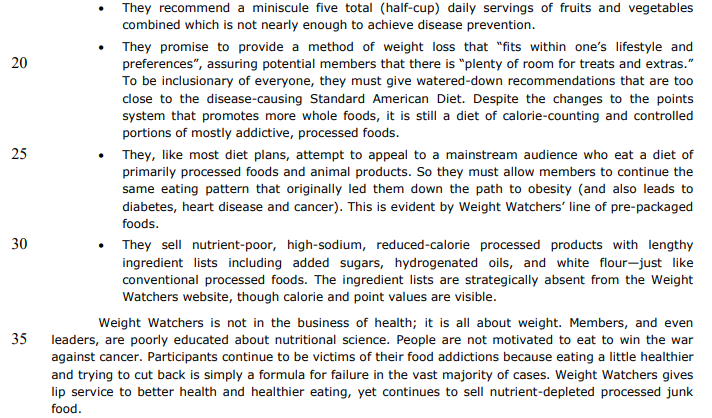

By Dr. Joel Fuhrman
Retrieved and adapted from https://www.drfuhrman.com/learn/library/articles/46/weight-watchers-focuses-onweight-not-health
Access on April 26, 2017.



By Dr. Joel Fuhrman
Retrieved and adapted from https://www.drfuhrman.com/learn/library/articles/46/weight-watchers-focuses-onweight-not-health
Access on April 26, 2017.



By Dr. Joel Fuhrman
Retrieved and adapted from https://www.drfuhrman.com/learn/library/articles/46/weight-watchers-focuses-onweight-not-health
Access on April 26, 2017.



By Dr. Joel Fuhrman
Retrieved and adapted from https://www.drfuhrman.com/learn/library/articles/46/weight-watchers-focuses-onweight-not-health
Access on April 26, 2017.



By Dr. Joel Fuhrman
Retrieved and adapted from https://www.drfuhrman.com/learn/library/articles/46/weight-watchers-focuses-onweight-not-health
Access on April 26, 2017.



By Dr. Joel Fuhrman
Retrieved and adapted from https://www.drfuhrman.com/learn/library/articles/46/weight-watchers-focuses-onweight-not-health
Access on April 26, 2017.



By Dr. Joel Fuhrman
Retrieved and adapted from https://www.drfuhrman.com/learn/library/articles/46/weight-watchers-focuses-onweight-not-health
Access on April 26, 2017.



By Dr. Joel Fuhrman
Retrieved and adapted from https://www.drfuhrman.com/learn/library/articles/46/weight-watchers-focuses-onweight-not-health
Access on April 26, 2017.



By Dr. Joel Fuhrman
Retrieved and adapted from https://www.drfuhrman.com/learn/library/articles/46/weight-watchers-focuses-onweight-not-health
Access on April 26, 2017.



By Dr. Joel Fuhrman
Retrieved and adapted from https://www.drfuhrman.com/learn/library/articles/46/weight-watchers-focuses-onweight-not-health
Access on April 26, 2017.
Read the lyrics below.
Don’t laugh at me
Mark Wills
I’m a little boy with glasses
The one they call the geek
A little girl who never smiles
’Cause I’ve got braces on my teeth
And I know how it feels
To cry myself to sleep
I’m that kid on every playground
Who’s always chosen last
A single teenage mother
Tryin’ to overcome my past
You don’t have to be my friend
But is it too much to ask
Don’t laugh at me
Don’t call me names
Don’t get your pleasure from my pain
In God’s eyes we’re all the same
Someday we’ll all have perfect wings
Don’t laugh at me (…)
Disponível em:<https://www.vagalume.com.br|> . Acesso em: 15 Set. 2017.
Will human beings ever live on other planets?
(1) __________ we have become accustomed to the idea of space travel, and in films and fiction it seems as tough space travel is inevitable, it appears unlikely that human beings will ever get any further than Mars, our nearest neighbor. No matter how many films we make about space travel, the fact is that it remains technologically challenging, and extremely expensive. (2) __________ the distances involved are immense, any voyage outside the solar system would take hundreds of years using current technology. Wherever human beings went into space, they would have problems of how to eat and breathe, and their spaceship would have to carry vast amounts of fuel (3) __________ cover the distance. Even Mars is so far away that it would take about six months to get there. (4) __________ the distance between Earth and Mars varies, astronauts would have to wait for nearly two years before they could return using the shortest journey time. (5) __________ it could cost as much as $ 100 billion, a manned mission to Mars is planned for sometime between 2010 and 2020.
VINCE, M. Macmillan English grammar in context. Macmillan, London. 2008. p. 165.
Check the CORRECT alternative.
O envelhecimento da população
O número de homens e mulheres nos EUA com 60 anos ou mais que ainda trabalham (1) __________ por mais de uma década. Economistas (2) __________ uma série de razões para essa tendência. Primeiro, desde 1985 a economia dos Estados Unidos (3) __________, portanto, tem havido um aumento da demanda por mão de obra. Ao mesmo tempo, o custo de alguns serviços, como cuidados de saúde, (4) __________, portanto, os trabalhadores precisam ganhar mais dinheiro mais tarde na vida. Além disso, as mudanças nas regras de benefícios da seguridade social (5) __________ um efeito considerável sobre os padrões de trabalho. (…)
VINCE, M. Macmillan English grammar in context. Macmillan, Londres. 2008. p. 23
Verifique a alternativa CORRETA .
Your gut, your emotions
What controls our emotions? The same two people might see the same tragic newspaper headline, (1) __________ one is much more emotionally affected than the other. Why is that? According to an international team led by UCLA researchers, these emotions may be partially driven by an unlikely source: our gut bacteria. In fact, the bacteria that colonize our intestines may influence the architecture of the brain itself.
The experiment examining the relationship between brain development and the gut microbiome was conducted with mice. Specific strains of mice, one that lacked a complete gut microbiome and one that had a normal microbiome, were compared in terms of their brain development and behavior. The influence of microorganisms is not limited to brain development.
Interestingly, the mice with the ―normal‖ microbiome had more anxiety and moved less than the mice without the microbiome. (2) __________ exposed to a microbiome early in life, the active, calm mice began to act more anxious and reduced their movements. Microbiota evidently had this influence by affecting hormonal expression and building particular pathways in the brain associated with anxiety. The influence on brain development apparently occurred at a particular point early in the mouse‘s life, so it‘s possible early exposure to a proper microbiome is important for normal development. The researchers speculate that the microbiome helps the mice develop an appropriate sense of caution.
The influence of microorganisms is not limited to brain development. (3) __________ no conclusive link has been established, a few studies have detected abnormalities in the gut microbiomes of children with Autism Spectrum Disorders compared to non-affected children. Nor is microorganism influence limited to gut bacteria. A separate study in hyenas (also awaiting conclusive proof) suggests that individual hyenas use a specific cocktail of stinky bacteria in their scent markers left as a message to other hyenas.
(4) __________ some fungus can get in on the act, hijacking ants and forcing the unfortunate insects to relocate to a place favorable for a fungus to grow. The ant does not survive, but it makes great fungus food. (5) __________ a growing body of evidence from other animals, until the UCLA study there was not much direct research on how the microbiome affects humans. But given its potential importance, hopefully there will soon be more research along these lines. Going with your gut, indeed!
Disponível em:< https://daily.jstor.org/your-gut-youremotions/?utm_term=YOUR%20GUT%2C%20YOUR%20EMOTIONS&utm_campaign=jstordaily_08032017&utm_content=e mail&utm_source=Act-On+Software&utm_medium=email>. Acesso em: 15 Set. 2017.
Check the CORRECT alternative.
The true potential of technology to change behavior
Technology could successfully change behaviours where decades of campaigns and legislation have failed. With the quantified self already walking among us and the internet of things within easy reach, digital technology is creating unprecedented opportunities to encourage, enable and empower more sustainable behaviours.
If we are to unlock the power of technology we must be more ambitious than simply digitising analogue strategies or creating another communications channel.
The true potential of technology lies in its ability to do things that nothing else can do. In behaviour change terms, the potential to succeed where decades of education programmes, awareness campaigns and product innovation have failed; to make a difference where government policy and legislation has had limited impact.
Using behavioural insights, it is possible to highlight the bottlenecks, drop out points and achilles heels of traditional behaviour change efforts — the reasons why we have failed in the past — and apply the unique possibilities of technology to these specific challenges.
Overcoming our limitations
Luckily, the history of the human race is almost defined by its ability to invent stuff that bolsters its feeble capabilities. That stuff is, of course, what we generically refer to as 'technology'. And in the same way that the internal combustion engine and the light bulb allow us to overcome our relatively feeble powers of motion and perception, so digital technology can be directed to overcoming our relatively feeble powers of reasoning, selfcontrol, motivation, self-awareness and agency—the factors that make behaviour change so difficult.
Herein lies the true potential of technology: not in the laboratory or the workshop, but in an understanding of the behavioural dynamics that define the human condition, both generally and within the context of a specific user-group, market segment or community.
Fonte: JOHNSON, Steven. Recognising the true potential of technology to change behaviour. Disponível em:<https://www.theguardian.com/sustainablebusiness/behavioural-insights/true-potential-technology-change-behaviour>
The true potential of technology to change behavior
Technology could successfully change behaviours where decades of campaigns and legislation have failed. With the quantified self already walking among us and the internet of things within easy reach, digital technology is creating unprecedented opportunities to encourage, enable and empower more sustainable behaviours.
If we are to unlock the power of technology we must be more ambitious than simply digitising analogue strategies or creating another communications channel.
The true potential of technology lies in its ability to do things that nothing else can do. In behaviour change terms, the potential to succeed where decades of education programmes, awareness campaigns and product innovation have failed; to make a difference where government policy and legislation has had limited impact.
Using behavioural insights, it is possible to highlight the bottlenecks, drop out points and achilles heels of traditional behaviour change efforts — the reasons why we have failed in the past — and apply the unique possibilities of technology to these specific challenges.
Overcoming our limitations
Luckily, the history of the human race is almost defined by its ability to invent stuff that bolsters its feeble capabilities. That stuff is, of course, what we generically refer to as 'technology'. And in the same way that the internal combustion engine and the light bulb allow us to overcome our relatively feeble powers of motion and perception, so digital technology can be directed to overcoming our relatively feeble powers of reasoning, selfcontrol, motivation, self-awareness and agency—the factors that make behaviour change so difficult.
Herein lies the true potential of technology: not in the laboratory or the workshop, but in an understanding of the behavioural dynamics that define the human condition, both generally and within the context of a specific user-group, market segment or community.
Fonte: JOHNSON, Steven. Recognising the true potential of technology to change behaviour. Disponível em:<https://www.theguardian.com/sustainablebusiness/behavioural-insights/true-potential-technology-change-behaviour>

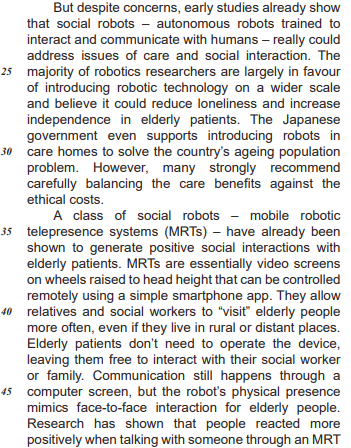
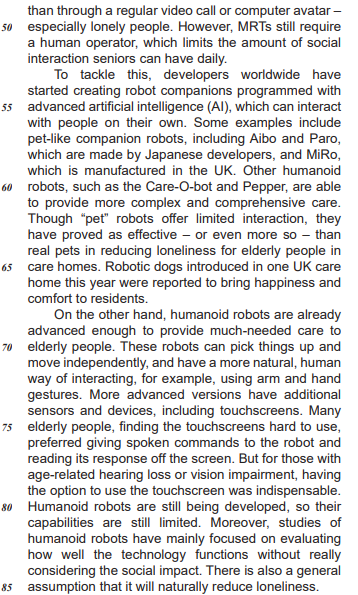
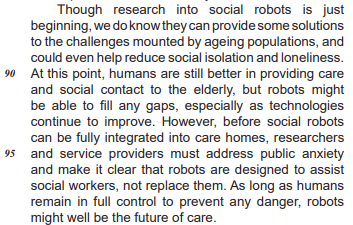
Available at:<https://www.independent.co.uk/life-style/gadgetsand-tech/features/robot-carer-elderly-people-lonelinessageing-population-care-homes-a8659801.html>. Retrieved on:
July 2, 2019. Adapted.